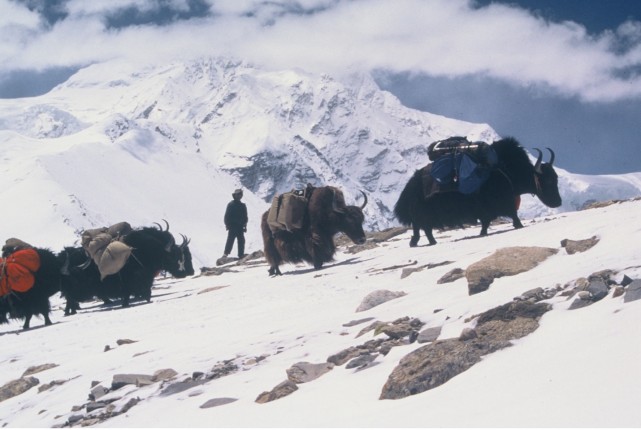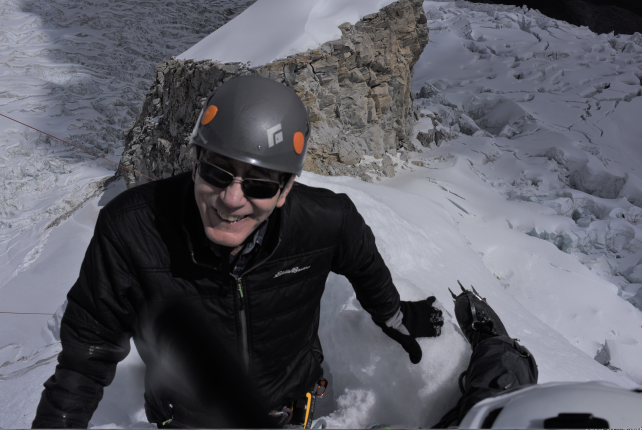-
No Water, No Food – Glacier Loss Threatens US and Chinese Agriculture
July 27, 2023 By Karen ManclPicture this: A parade of yaks carrying insulated boxes containing meter-long ice core samples from Tibetan glaciers. “Yaks are like cats,” elite glacier scientist Lonnie Thompson explained in a 2023 Wilson Center webinar. They like to wander off — and it takes experienced Tibetan yak herders to keep them moving in the same direction.
Yet these yak-schlepped ice cores are essential to climate science, added Ellen Mosely Thompson. They store thousands of years of atmospheric dust and gasses in distinct layers and serve as a record of our changing climate.
Glaciers store 68.7% of the world’s fresh water. Snow and glaciers in the Hindu Kush Himalayas and the Tibetan Plateau contain the largest volume of fresh water outside of Earth’s polar ice sheets.
This massive natural resource held in these glaciers has led hydrologists to dub this region the Third Pole. Yet global warming is accelerating glacial melt in this region, threatening water, food security and ecosystems, and the lives of hundreds of millions across Asia.
Surveying Climate from the Third Pole
For 40 years now, Lonnie and Ellen Thompson have worked at the Third Pole with their colleague Tandong Yao (Institute of Tibetan Plateau Research). They were the first scientists to sound the alarm on our changing climate and what its impacts meant for the world’s glaciers.
Together with Volker Mosbrugger, this team also established the Third Pole Environment (TPE) in 2009. It is an international program for the interdisciplinary study of water, ice, air, ecology, and humankind in the Third Pole region and beyond. After establishing the first TPE center in China, a US Center opened at the Ohio State University in 2016 — the first outside the Third Pole Region.
Lonnie Thompson has scaled mountain ranges around the world to collect ice cores to study the earth’s changing weather patterns. Ellen Mosely Thompson studies the same trends in glaciers in Antarctica and Greenland. Over decades, their research has documented glacial retreat, with Lonnie describing glaciers as the “first responders to climate change.”
Together, the Thompsons have collaborated with Chinese, American, and European scientists over many decades, uncovering how glaciers found in the mountains closer to the equator can help us understand the planet’s changing weather patterns and climate threats to water and food security.
How Glaciers Feed Agricultural Water Supplies
Glacial melt threatens agricultural water supplies around the world — and US and Chinese crops are not immune to this water loss. The consequences are significant. Even staples of modern life such as beer and tee shirts are at risk as the raw materials used to manufacture them are grown on agricultural fields irrigated by the meltwater from glaciers.
For instance, most of the hops used to flavor beer are grown in the US Pacific Northwest with irrigation water originating from the Columbia River. The glaciers in the mountains of western Canada feed this river, especially in the dry summer months. China is the world’s largest cotton producer. Tee shirts are created with cotton grown mostly in northwestern China, where the Tarim River irrigates the fields with water from the glaciers of the Tian Shan mountains.
Glaciers provide watersheds with a more stable water supply than those fed only by annual rainfall and snow melt. They act as a water tower to sustain the river flow. Thus, critical agricultural water supplies are threatened by the loss of glaciers. Over the past 20 years, scientists have recorded a 20% loss of glaciers in the Wind River Range that supplies water for hay, barley, and cattle production in western Wyoming.
Obstacles to Glacier Science Research
Since 1984, Lonnie Thompson has made 28 trips to China, where he has witnessed the growing investments China was making into glacier education and research. He noted in his webinar that the new campuses have been built in Beijing and Lhasa to study the Himalayan glaciers often boast research equipment superior to his own.
Good equipment — and resilience — is much needed for this work. For years now, the Chinese and US scientists from the Third Pole Centers have surmounted the complex logistics of transporting drilling equipment to safely move ice cores on stubborn yaks.
Lonnie Thompson’s own Third Pole trips were paused in 2011 when he experienced heart failure and needed a heart transplant. But three and a half years after his transplant, he was back in Tibet in 2015 collecting ice cores at an altitude of 6,700 meters.
These scientists also have faced the challenges obtaining visas amid political tensions. Increasingly strained US-China relations over the past six years have created a chilling effect on international collaboration in glacier climate research. With the added challenge of the pandemic, mountain explorations and research exchanges in the region shut down almost completely.
Despite these political and public health challenges, Chinese and US glacier scientists found ways to continue research cooperation, communicating online and writing joint papers. In November this year, following the disruptions created by COVID-19, US and Chinese glacier scientists will reconvene at the International Symposium on Third Pole Environment in Chongqing. And a new generation is rising to the task. Lonnie and Ellen Thompson’s first Tibetan woman PhD graduate is now doing field work in Lhasa.
Immediate Action on Glaciers Is Needed
Without a reliable supply of water, food production in the northwestern regions of both China and the United States is threatened. The nearly $14 billion of fruit, grain, and potatoes grown in Washington, Oregon, and Idaho will need to adapt as precipitation is shifting from snow to more rain — and the reliable melt waters from glaciers are disappearing. The agriculture of northwestern China is the most vulnerable in the face of climate change. Continued crop expansion in this region may be unsustainable with the loss of glaciers driving water scarcity.
And as the glaciers continue to melt away, both the United States and China will be losing more than just beer and tee shirts. As Ellen Thompson warned in the webinar: “We are losing the record of how the earth’s atmosphere has been changing.”
The United States and China are trying to restart conversations on their common climate challenges. It is notable that in the 2022 US-China Glasgow Climate Agreement, green and climate resilient agriculture was flagged as an area of mutual interest. Expanding support for US and Chinese joint glacier science could strengthen food and human security in both countries.
This blog is part of a new China Environment Forum-Ohio State University project “Cultivating US and Chinese Climate Leadership in Food and Agriculture.”
Karen Mancl is a Professor of Food, Agricultural and Biological Engineering at The Ohio State University, where she is also the Director of the OSU Soil Environment Technology Learning Lab. She holds a PhD in Water Resources from Iowa State University, an MA in East Asian Studies and an MA in Public Policy from Ohio State University. Karen was selected as a 2023 Wilson Center Fellow.
Sources: Agricultural Water Management, Beer Maverick, Byrd Polar and Climate Research Center, Canadian Columbia Basin Glacier and Snow Research Network, Environmental Research Letters, Frontiers, New York Times, PBS Frontline, Remote Sensing, Scientific American, Scienceline, Statista, Third Pole Environment, USDA
Lead photo credit: Yaks schlepping ice core samples off the Tibetan Plateau, photo courtesy of Lonnie Thompson
Second photo credit: Lonnie Thompson scaling Himalayas in 2015 after recovering from a heart transplant, photo courtesy of Lonnie’s long-time head mountaineer, Benjamin Felix Vicencio
 A Publication of the Stimson Center.
A Publication of the Stimson Center.





